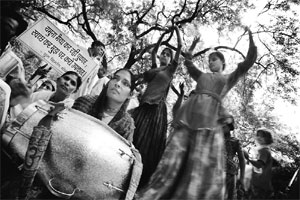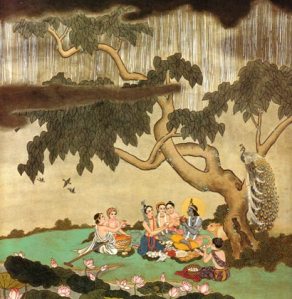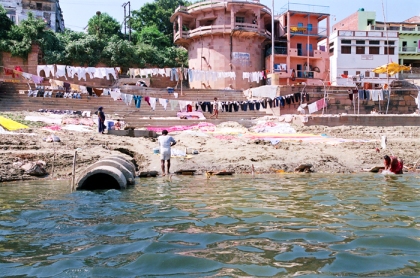Filed under: Uncategorized
 We are sorry to announce that this blog will again be inactive for an indefinite amount of time. Instead, please visit our blogging friends at The Yoga of Ecology for regular posts dealing with nature and spirituality.
We are sorry to announce that this blog will again be inactive for an indefinite amount of time. Instead, please visit our blogging friends at The Yoga of Ecology for regular posts dealing with nature and spirituality.
By Pankaj Jain, Ph.D., Huffpost
Hinduism contains numerous references to the worship of the divine in nature in its Vedas,
Upanishads, Puranas, Sutras and its other sacred texts. Millions of Hindus recite Sanskrit mantras daily to revere their rivers, mountains, trees, animals and the earth. Although the Chipko (tree-hugging) Movement is the most widely known example of Hindu environmental leadership, there are examples of Hindu action for the environment that are centuries old.
Hinduism is a remarkably diverse religious and cultural phenomenon, with many local and
regional manifestations. Within this universe of beliefs, several important themes emerge. The diverse theologies of Hinduism suggest that:
• The earth can be seen as a manifestation of the goddess, and must be treated with respect.
• The five elements — space, air, fire, water and earth — are the foundation of an interconnected web of life.
• Dharma — often translated as “duty” — can be reinterpreted to include our responsibility to care for the earth.
• Simple living is a model for the development of sustainable economies.
• Our treatment of nature directly affects our karma. Continue reading
By Irena Akbar, Indian Express
As if overwhelmed by the sea of humanity and media frenzy that engulfed it during the week-long Anna Hazare-led anti-corruption agitation, Jantar Mantar, Delhi’s protest street, looks unusually calm on a Thursday. There are three protest stalls, all by Hazare wannabes clamouring for a corruption-free India, except that this time neither the media nor the public has bothered to stop by to listen. Or perhaps, it’s just that the harsh sun has got the better of protesters and their supporters.
Around noon, the silence at Jantar Mantar is disturbed by a cavalcade of 20 vehicles that includes SUVs, vans, a water tank, and a generator, all with posters that read, “Yamuna Bachao Padyatra”. Some 100-odd men and women dressed in dhotis and lehengas are part of this procession, the women dancing and singing bhajans in praise of Radha and Krishna. Kusum Sharma is part of this procession, singing into the mike and dancing, her lehenga obliging with neat twirls. The cavalcade comes to a halt. There is no podium, no stall, but this pavement abutting the Jantar Mantar has no marked out spaces, at least not on this unhurried sultry afternoon, so Sharma and the other protesters take out mats and bed sheets and spread themselves across the pavement. Continue reading
Article from The Times of India
Hundreds of ‘sadhus’ from Braj Mandal, `bhakts’ of Lord Krishna, farmers, environmentalists and residents of Etawah participated in a `padyatra’ to save the Yamuna from pollution.
The march which started from Allahabad on March 3, covered Kaushambi, Fatehpur, Kanpur and Auraiyya to reached Etawah on Tuesday.
A dharna will be held at Jantar Mantar in New Delhi on April 15 to highlight the issue.
Holding placards and banners, the `patyatris’ assembled on the banks of Yamuna in Etawah and sang `bhajans’ and `kirtans’ in order to gather support for the cause.
“Yamuna, considered as a pious in mythology, is now counted among the most polluted rivers in India,” said Bhanu Pratap Singh, president Bhartiya Kisan Union, Mathura. Delhi alone contributes around 3,296 mld (million litres per day) of sewage in the form of drains which fall into the river. Lakhs of people are living in the slums on the banks of Yamuna river, he said. Shortage of sewage treatment plants and lack of sanitation facilities in Delhi are responsible for polluting the Yamuna. The problem is further compounded by lack of minimum perennial fresh water flow in the river along the stretch starting from Wazirabad, Singh added.
By Brij Khandelwal, India News Post
A movement launched by the ascetics and Sri Krishna devotees of the Braj Mandal to save the Yamuna river from pollution is now gaining momentum. Hundreds of ascetics and activists have reached Sangam (confluence) at Allahabad from where a long march to New Delhi is to start Wednesday. Chief organisers Radha Krishan Shastri and Jai Krishan Das told IANS the march will reach the capital around April 15.
They said they will not withdraw till their demands are met and will talk only with Prime Minister Manmohan Singh, President Pratibha Patil or UPA chairperson Sonia Gandhi.
For the next 45 days, river Yamuna will remain in the focus as the march moves towards New Delhi via smaller towns and villages. By the time it reaches Agra, the organisers hope it will gain sufficient momentum. This is the first time that the alarming pollution in the Yamuna has attracted so many people who look determined to set things right, said eco-activist Ravi Singh in Agra. Continue reading
Filed under: Uncategorized
 We apologize that for the next year, this blog will be inactive. Instead, please visit our friends at The Yoga of Ecology for regular posts dealing with nature and spirituality.
We apologize that for the next year, this blog will be inactive. Instead, please visit our friends at The Yoga of Ecology for regular posts dealing with nature and spirituality.
Filed under: Uncategorized
Article from Deccan Herald
Amid uproarious scenes, Karnataka Assembly today passed the controversial cow slaughter ban Bill, which provides for stringent punishment for violaters and makes the offence cognisable and non-bailable.
After more than a four-hour debate, the Bill was passed by voice-vote as the entire opposition — Congress and JDS — trooped into the well of the House and shouted anti-government slogans, branding the BJP government “communal”.
Leader of Opposition Siddaramaiah, who termed the legislation “draconian”, “anti-secular” and “unconstitutional” tore a copy of the the Karnataka Prevention of Slaughter and Preservation of Cattle Bill, 2010 — and threw it in the air.
Earlier, Chief Minister B S Yeddyurappa defended the Bill, saying it was aimed at protecting cows and preserve cattle in Karnataka. A number of states, including Gujarat, Madhya Pradesh, Chhatisgarh and Jammu and Kashmir, already had similar legislation, he added.
Cow slaughter ban is in force in Cuba and Iran, Yeddyurappa said, and highlighted the medicinal benefits of cow urine which have been proved by research.The bill prohibits slaughter of cattle, sale, usage and possession of beef, puts restriction on transport of cattle and also prohibits sale, purchase or disposal of cattle for slaughter. Continue reading
Filed under: Uncategorized
From the Indian Ministry of Environment and Forests
In the context of environmental Audit, the Ministry of Environment and Forests is engaged with looking at innovation in governance since the past few months. Two very important initiatives are ongoing, namely the National Green Tribunal (NGT) with a network of specialized Environment Courts and National Environment Protection Authority (NEPA). Delivering a key note address at the two day conference on a ‘Environment Audit – Concerns about Water Pollution in India’ organized by the Comptroller and Auditor-General of India here today, Shri Jairam Ramesh, Minister of State for Environment and Forests (I/C) said the NGT will give the Indian citizen first time judicial remedy as far as environmental damages are concerned. India would be the first country in the world to have such an extensive network of specialized environment courts. Shri Jairam expressed the view that environment is still seen not as an essential function such as economic activity, but as an additional cost that has to be borne. Unless and until, we internalize issues relating to environment as part of normal process of economic decision making, we will not get the kind of seriousness on matters relating to environments. Continue reading
Filed under: Vedas
“The Lord reciprocated the feelings of the inhabitants of the forest of Vrindavana. When there was rainfall, the Lord took shelter at the feet of the trees or in the caves and enjoyed the taste of different fruits with his eternal associates the cowherd boys. He played with them, sat with them, and ate fruits with them.”
–Light of the Bhagavata, Verse 24
(c) The Bhaktivedanta Book Trust International, Inc.
Filed under: Uncategorized
By Krishna Pokharel, The Wall Street Journal
VARANASI, India—More than a million devout Hindus bathed in the Ganges River Friday, braving the risk of terrorist attack, stampede and petty crime for the chance to wash away the sins of a lifetime and open the gateway to heaven after death.
But perhaps the greatest threat to the devotees who flocked to Haridwar, India, on one of the most auspicious days of the triennial Kumbh Mela festival, was the water itself.
The river is intensely polluted with sewage and industrial waste. Water-treatment facilities have been unable to keep up with India’s rapid growth, often held back by a shortage of funds and other resources.
A dip in the Ganges River in India is believed by devotees to wash away all sins. But increasingly it has become heavily polluted with sewage and industrial waste. Now, a $4 billion government program aims to clean the river.
Now, the spiritually cleansing waters of the Ganges are about to get some cleaning of their own. The Indian government has embarked on a $4 billion campaign to ensure that by 2020 no untreated municipal sewage or industrial runoff enters the 1,560-mile river.
Only 31% of municipal sewage in India undergoes treatment, according to the Central Pollution Control Board, a government agency in New Delhi, while the rest gets discharged into the country’s rivers, ponds, land and seas, contaminating underground and surface waters. More than 500,000 of the 10.3 million deaths in India in 2004 resulted from waterborne diseases, according to the most recent comprehensive mortality data from the World Health Organization.
The filth in the Ganges holds special resonance for this majority-Hindu nation. The Ganges basin supports more than 400 million of India’s 1.1 billion people, the majority of whom are Hindus, who revere the river as “mother” and “goddess.”
Cleaning the Holy Ganges
The cleanup initiative, which is supported by the World Bank, includes the expansion of traditional treatment facilities and, for the first time in India, the introduction of innovative river-cleaning methods.
Veer Bhadra Mishra, a 70-year-old priest and hydraulics engineer in Varanasi, the holy city downstream from Haridwar, has been a prominent advocate of treatment methods used abroad but not yet in India. His plan: to introduce a system to divert sewage and effluents, before they enter the river, to a series of specially designed ponds, for treatment and ultimately to be used use in irrigation or directed back into the river.
His efforts were mired in court and by opposition from local bureaucrats. The bureaucrats had a “difference of opinion” with Mr. Mishra about the best way to clean the river, says Ramesh Singh, general manager of Ganga Pollution Control Unit, the local government body charged with running government treatment facilities in Varanasi.
Mr. Singh says the technologies already in use were time-tested and reliable, but suffered from a lack of trained manpower and proper infrastructure, and a shortage of funds for equipment maintenance.
Last summer, after Prime Minister Manmohan Singh identified cleaning up the river as a national priority, the government in New Delhi increased funding to operate and maintain conventional treatment facilities, and also approved Mr. Mishra’s plan—giving $184,000 to his organization, the Sankat Mochan Foundation, for the design of a new sewage treatment plant.
The foundation is working with GO2 Water Inc., a Berkeley, Calif., wastewater-technology company. In the plan, 10.5 million gallons of sewage a day—13% of the daily output from Varanasi’s 1.5 million people—will be intercepted daily at the riverbank, and diverted. In a nearby village, water will pass through a series of ponds, where sunlight, gravity, bacteria and microalgae will clean the water. A larger pond system is planned, to process 33% more of the city’s sewage.
The treatment system “will be the best solution for dealing with huge amount of domestic sewage being discharged into Gangaji and other rivers in India,” Mr. Mishra said, using the honorific “ji” with the river’s local name, Ganga.
In Haridwar, the National Botanical Research Institute is developing a wetland with local species of reeds to absorb the polluting elements from the wastewater, according to U.N. Rai, a scientist heading the project. Other wetlands will be developed in other areas “to ease the current pollution load in the river,” Mr. Rai says.
The load is heavy. On a recent winter morning in Varanasi, lab technician Gopal Pandey descended the stone stairs of Tulsi Ghat, one of the holy city’s 84 bathing platforms, to fetch some Ganges water for testing at the Sankat Mochan Foundation, an organization run by Mr. Mishra.
In the laboratory, Mr. Pandey found that each 100 milliliters of the river’s waters were laden with 29,000 fecal coliform bacteria, which potentially cause disease. India says a maximum of 500 per 100 milliliters is safe for bathing in the river. Another sample from downstream, after the Ganges meets a tributary carrying a black mass of thick industrial effluents, showed 10 million bacteria—mostly E-coli—in the same amount of river water. Mr. Pandey’s verdict: “The pollution is at very, very dangerous level.”
 "We do not condemn modern civilization but we don't like to get it at the cost of God Consciousness, that is suicide."
__________________________________
The Beauty of Beans
"We do not condemn modern civilization but we don't like to get it at the cost of God Consciousness, that is suicide."
__________________________________
The Beauty of Beans
 "One acre of beans produces ten times more protein than an acre of pasture set aside for meat production." -Higher Taste
"One acre of beans produces ten times more protein than an acre of pasture set aside for meat production." -Higher Taste
 Moundsville, West Virginia
_________________________________
ISKCON Gita Nagari Farm Community
Moundsville, West Virginia
_________________________________
ISKCON Gita Nagari Farm Community
 Port Royal, Pennsylvania
_________________________________
ISKCON New Goloka Farm Community
Port Royal, Pennsylvania
_________________________________
ISKCON New Goloka Farm Community
 Hillsborough, North Carolina
_________________________________
ISKCON New Talavan Farm Community
Hillsborough, North Carolina
_________________________________
ISKCON New Talavan Farm Community
 Carriere, Mississippi
_________________________________
ISKCON Saranagati Eco-Village
Carriere, Mississippi
_________________________________
ISKCON Saranagati Eco-Village
 British Columbia, Canada
_______________________________
ISKCON Gaura Vrindaban
British Columbia, Canada
_______________________________
ISKCON Gaura Vrindaban
 Paraty, Brazil
_________________________________
ISKCON Krishna Valley Farm Community
Paraty, Brazil
_________________________________
ISKCON Krishna Valley Farm Community
 Somogyvamos, Hungary
_________________________________
Bhaktivedanta Eco-Village
Somogyvamos, Hungary
_________________________________
Bhaktivedanta Eco-Village
 Sagar Taluq, South India
_________________________________
ISKCON Cow Protection
Sagar Taluq, South India
_________________________________
ISKCON Cow Protection
 "There are so many facilities afforded by cow protection, but people have forgotten these arts. The importance of protecting cows is therefore stressed by Krsna in Bhagavad-gita (krsi-go-raksya-vanijyam vaisya-karma svabhavajam [Bg. 18.44]). Even now in the Indian villages surrounding Vrndavana, the villagers live happily simply by giving protection to the cow. They keep cow dung very carefully and dry it to use as fuel. They keep a sufficient stock of grains, and because of giving protection to the cows, they have sufficient milk and milk products to solve all economic problems. Simply by giving protection to the cow, the villagers live so peacefully. Even the urine and stool of cows have medicinal value."
-Srila Prabhupada
_________________________________
"There are so many facilities afforded by cow protection, but people have forgotten these arts. The importance of protecting cows is therefore stressed by Krsna in Bhagavad-gita (krsi-go-raksya-vanijyam vaisya-karma svabhavajam [Bg. 18.44]). Even now in the Indian villages surrounding Vrndavana, the villagers live happily simply by giving protection to the cow. They keep cow dung very carefully and dry it to use as fuel. They keep a sufficient stock of grains, and because of giving protection to the cows, they have sufficient milk and milk products to solve all economic problems. Simply by giving protection to the cow, the villagers live so peacefully. Even the urine and stool of cows have medicinal value."
-Srila Prabhupada
_________________________________
 "The Personality of Godhead is perfect and complete, and because He is completely perfect, all emanations from Him, such as this phenomenal world, are perfectly equipped as complete wholes. Whatever is produced of the Complete Whole is also complete in itself. Because He is the Complete Whole, even though so many complete units emanate from Him, He remains the complete balance."
_________________________________
MANTRA ONE
"The Personality of Godhead is perfect and complete, and because He is completely perfect, all emanations from Him, such as this phenomenal world, are perfectly equipped as complete wholes. Whatever is produced of the Complete Whole is also complete in itself. Because He is the Complete Whole, even though so many complete units emanate from Him, He remains the complete balance."
_________________________________
MANTRA ONE
 "Everything animate or inanimate that is within the universe is controlled and owned by the Lord. One should therefore accept only those things necessary for himself, which are set aside as his quota, and one should not accept other things, knowing well to whom they belong."
_________________________________
MANTRA TWO
"Everything animate or inanimate that is within the universe is controlled and owned by the Lord. One should therefore accept only those things necessary for himself, which are set aside as his quota, and one should not accept other things, knowing well to whom they belong."
_________________________________
MANTRA TWO
 "One may aspire to live for hundreds of years if he continuously goes on working in that way, for that sort of work will not bind him to the law of karma. There is no alternative to this way for man."
_________________________________
MANTRA THREE
"One may aspire to live for hundreds of years if he continuously goes on working in that way, for that sort of work will not bind him to the law of karma. There is no alternative to this way for man."
_________________________________
MANTRA THREE
 "The killer of the soul, whoever he may be, must enter into the planets known as the worlds of the faithless, full of darkness and ignorance."
_________________________________
MANTRA FOUR
"The killer of the soul, whoever he may be, must enter into the planets known as the worlds of the faithless, full of darkness and ignorance."
_________________________________
MANTRA FOUR
 "Although fixed in His abode, the Personality of Godhead is swifter than the mind and can overcome all others running. The powerful demigods cannot approach Him. Although in one place, He controls those who supply the air and rain. He surpasses all in excellence."
_________________________________
MANTRA FIVE
"Although fixed in His abode, the Personality of Godhead is swifter than the mind and can overcome all others running. The powerful demigods cannot approach Him. Although in one place, He controls those who supply the air and rain. He surpasses all in excellence."
_________________________________
MANTRA FIVE
 "The Supreme Lord walks and does not walk. He is far away, but He is very near as well. He is within everything, and yet He is outside of everything."
_________________________________
MANTRA SIX
"The Supreme Lord walks and does not walk. He is far away, but He is very near as well. He is within everything, and yet He is outside of everything."
_________________________________
MANTRA SIX
 "He who sees everything in relation to the Supreme Lord, who sees all living entities as His parts and parcels, and who sees the Supreme Lord within everything never hates anything or any being."
_________________________________
MANTRA SEVEN
"He who sees everything in relation to the Supreme Lord, who sees all living entities as His parts and parcels, and who sees the Supreme Lord within everything never hates anything or any being."
_________________________________
MANTRA SEVEN
 "One who always sees all living entities as spiritual sparks, in quality one with the Lord, becomes a true knower of things. What, then, can be illusion or anxiety for him?"
_________________________________
MANTRA EIGHT
"One who always sees all living entities as spiritual sparks, in quality one with the Lord, becomes a true knower of things. What, then, can be illusion or anxiety for him?"
_________________________________
MANTRA EIGHT
 "Such a person must factually know the greatest of all, the Personality of Godhead, who is unembodied, omniscient, beyond reproach, without veins, pure and uncontaminated, the self-sufficient philosopher who has been fulfilling everyone's desire since time immemorial."
_________________________________
MANTRA NINE
"Such a person must factually know the greatest of all, the Personality of Godhead, who is unembodied, omniscient, beyond reproach, without veins, pure and uncontaminated, the self-sufficient philosopher who has been fulfilling everyone's desire since time immemorial."
_________________________________
MANTRA NINE
 "Those who engage in the culture of nescient activities shall enter into the darkest region of ignorance. Worse still are those engaged in the culture of so-called knowledge."
_________________________________
MANTRA TEN
"Those who engage in the culture of nescient activities shall enter into the darkest region of ignorance. Worse still are those engaged in the culture of so-called knowledge."
_________________________________
MANTRA TEN
 "The wise have explained that one result is derived from the culture of knowledge and that a different result is obtained from the culture of nescience."
_________________________________
MANTRA ELEVEN
"The wise have explained that one result is derived from the culture of knowledge and that a different result is obtained from the culture of nescience."
_________________________________
MANTRA ELEVEN
 "Only one who can learn the process of nescience and that of transcendental knowledge side by side can transcend the influence of repeated birth and death and enjoy the full blessings of immortality."
_________________________________
MANTRA TWELVE
"Only one who can learn the process of nescience and that of transcendental knowledge side by side can transcend the influence of repeated birth and death and enjoy the full blessings of immortality."
_________________________________
MANTRA TWELVE
 "Those who are engaged in the worship of demigods enter into the darkest region of ignorance, and still more so do the worshipers of the impersonal Absolute."
_________________________________
MANTRA THIRTEEN
"Those who are engaged in the worship of demigods enter into the darkest region of ignorance, and still more so do the worshipers of the impersonal Absolute."
_________________________________
MANTRA THIRTEEN
 "It is said that one result is obtained by worshiping the supreme cause of all causes and that another result is obtained by worshiping what is not supreme. All this is heard from the undisturbed authorities, who clearly explained it."
_________________________________
MANTRA FOURTEEN
"It is said that one result is obtained by worshiping the supreme cause of all causes and that another result is obtained by worshiping what is not supreme. All this is heard from the undisturbed authorities, who clearly explained it."
_________________________________
MANTRA FOURTEEN
 "One should know perfectly the Personality of Godhead Śrī Kṛṣṇa and His transcendental name, form, qualities and pastimes, as well as the temporary material creation with its temporary demigods, men and animals. When one knows these, he surpasses death and the ephemeral cosmic manifestation with it, and in the eternal kingdom of God he enjoys his eternal life of bliss and knowledge."
_________________________________
MANTRA FIFTEEN
"One should know perfectly the Personality of Godhead Śrī Kṛṣṇa and His transcendental name, form, qualities and pastimes, as well as the temporary material creation with its temporary demigods, men and animals. When one knows these, he surpasses death and the ephemeral cosmic manifestation with it, and in the eternal kingdom of God he enjoys his eternal life of bliss and knowledge."
_________________________________
MANTRA FIFTEEN
 "O my Lord, sustainer of all that lives, Your real face is covered by Your dazzling effulgence. Kindly remove that covering and exhibit Yourself to Your pure devotee."
_________________________________
MANTRA SIXTEEN
"O my Lord, sustainer of all that lives, Your real face is covered by Your dazzling effulgence. Kindly remove that covering and exhibit Yourself to Your pure devotee."
_________________________________
MANTRA SIXTEEN
 "O my Lord, O primeval philosopher, maintainer of the universe, O regulating principle, destination of the pure devotees, well-wisher of the progenitors of mankind, please remove the effulgence of Your transcendental rays so that I can see Your form of bliss. You are the eternal Supreme Personality of Godhead, like unto the sun, as am I."
_________________________________
MANTRA SEVENTEEN
"O my Lord, O primeval philosopher, maintainer of the universe, O regulating principle, destination of the pure devotees, well-wisher of the progenitors of mankind, please remove the effulgence of Your transcendental rays so that I can see Your form of bliss. You are the eternal Supreme Personality of Godhead, like unto the sun, as am I."
_________________________________
MANTRA SEVENTEEN
 "Let this temporary body be burnt to ashes, and let the air of life be merged with the totality of air. Now, O my Lord, please remember all my sacrifices, and because You are the ultimate beneficiary, please remember all that I have done for You."
_________________________________
MANTRA EIGHTEEN
"Let this temporary body be burnt to ashes, and let the air of life be merged with the totality of air. Now, O my Lord, please remember all my sacrifices, and because You are the ultimate beneficiary, please remember all that I have done for You."
_________________________________
MANTRA EIGHTEEN
 "O my Lord, as powerful as fire, O omnipotent one, now I offer You all obeisances, falling on the ground at Your feet. O my Lord, please lead me on the right path to reach You, and since You know all that I have done in the past, please free me from the reactions to my past sins so that there will be no hindrance to my progress."
"O my Lord, as powerful as fire, O omnipotent one, now I offer You all obeisances, falling on the ground at Your feet. O my Lord, please lead me on the right path to reach You, and since You know all that I have done in the past, please free me from the reactions to my past sins so that there will be no hindrance to my progress."




